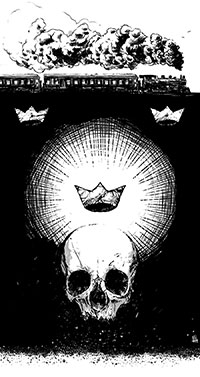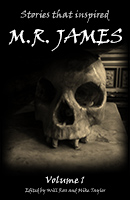 The waiting is over, it’s finally time for Mike & Will to tackle what is arguably M.R. James’s masterpiece – A Warning to the Curious! It’s a biggie, so we will split our coverate of this story over two episodes. Our examination of this story will conclude in episode 31.
The waiting is over, it’s finally time for Mike & Will to tackle what is arguably M.R. James’s masterpiece – A Warning to the Curious! It’s a biggie, so we will split our coverate of this story over two episodes. Our examination of this story will conclude in episode 31.
To assist them in their task, Mike and Will are joined by Tom Baynham, whose article ‘A Return to Seaburgh’ sheds much light on the real-world locations which feature in this story.
Once again big thanks go out to Alisdair Wood for providing the awesome artwork. You can now purchase a set of eight postcards featuring Alisdair’s great M.R. James illustrations. Snap them up while you can from Alisdair’s online shop.
The excellent readings which accompany this episode were provided by Lewis Davies.
Show notes:
- Story locations
In his introduction to ‘Collected Ghost Stories’ M.R. James explained that he based the town of Seaburgh on Aldeburgh in Suffolk. The actual locations featured in this story have been explored in a few articles in Ghosts & Scholars: ‘A Visit to Seaburgh‘ by Darroll Pardoe (G&S 15), ‘Cambridge and Suffolk: A Perambulation of Two Counties’ by Brian J. Showers (G&S Newsletter 14 – not available online) and ‘A Return to Seaburgh’ by Tom Baynham (G&S Newsletter 23 – not available online). See also the White Lion Hotel. To see the locations features in this story on a map, visit Monty’s World, our M.R. James map. - Snape Common Anglo-Saxon Cemetary (Wikipedia)
The idea of buried Anglo-Saxon treasure was probably inspired by the real archeological finds uncovered at nearby Snape Common during the 19th century. The story also mentions the crown found at Rendlesham, a reference to the real crown found at the famous burial mounds at Sutton Hoo, near Rendlesham. - ‘”No Thoroughfare” – The problem of Paxton’ by Mike Pincombe (Ghosts & Scholars 32)
This fascinating article (sadly not available online) explores the implications of a wartime setting for ‘A Warning to the Curious’. For an entirely different take on the character of Paxton, see Pincombe’s very entertaining essay ‘Homosexual Panic and the English Ghost Story‘ (G&S Newsletter 2)! - ‘Lay of a Last Survivor- Beowulf, the Great War, and M.R. James’s “A Warning to the Curious” ‘ by Patrick J. Murphy and Fred Porcheddhu (not yet published)
This article reveals the connection between this story and Beowulf, and elaborates on Mike Pincombe’s suggestions about the importance of WWI to the understanding of this story. - ‘”The Rules of Folklore” in the stories of M.R. James’ by Jacqueline Simpson (Warnings to the Curious, Hippocampus Press, 2007)
This essay mentions various possible precedents to the myth of the Three Crowns, including the legend of Bran the Blessed and Drake’s Drum. - The name ‘Ager’ (Surname Database)
It seems that ‘Ager’ is indeed a local name of some pedigree in the Suffolk and Cambridge area.
As if a bumper 2-parter on ‘A Warning to the Curious’ wasn’t enough, we have also produced a short video comprising footage taken on our recent visit to Aldeburgh, and featuring locations from the story such as Aldeburgh Parish Church, the White Lion Hotel (‘the Bear’ from the story), Wyndham House (home of M.R. James’s grandparents), the Martello Tower, Sluice Cottage (the likely site of William Ager’s house) and even a spot which matches James’s description and location of the mound where Paxton finds the crown!
Podcast: Play in new window | Download
Subscribe: RSS
Tags: A Warning to the Curious, Aldeburgh, Anglo-saxon crown, Ghost Story, Henry Long, M.R. James, Paxton, Seaburgh, WWI








My absolute favourite James tale, the melancholy that pervades it is really atmospheric, glad to see it is being done justice with two lengthy episodes.
On a side note, I read the PJ Murphy and Fred Porcheddu essay on “An Episode of Cathedral History”, in it they cover a number of references made by James to Charles Dickens unfinished tale “Edwin Drood”. Evidently James and his pals went to some of the real world locations in that fictional unfinished story to try and solve the mystery in it.
It struck me as both amusing and comforting that M.R. James was doing the exact same thing that a number of his fans (including myself) would do decades later, visiting the real world locations of his literary hero.
I have to say I did visit Theberton church not so long ago and wasn’t convinced with the 3 crowns motif. Froston for me is an amalgamation of several village churches in that area, Friston is an obvious geographical location and has a very old church, Thorpeness, while very pretty is a relatively modern build and lacks the requisite history behind it, and is perhaps why James considered it then decided against using it.
I know what you mean – that aspect of Monty’s character really chimed with me. I find it hard to square the fannish, playful enthusiast with what we know of the more conservative and institutional aspects to his character. That distinction seems really important to this story, which appears to reflect on the war and his own role in it.
Congratulations on an absolutely superb episode!
I just happened to come upon an excellent description of a “Martello” tower this morning, rereading Patrick O’Brian’s novel _The Surgeon’s Mate_.
“The Mortella tower in Corsica –the Martello, as some say, the round tower we have copied by the score all round the coast. It was ordered to be taken in 1794; and although it only had two eighteen-pounders and a six, with thirty-two men and a young ensign to serv them, Lord Hood sent both _Juno_ and _Fortitude_ in to batter it, while the army landed fourteen hundred men. Well, the ships battered away for two hours and more, and by the end of that time _Fortitude_ had sixty-two men killed and wounded, three guns dismounted, her mainmast shot through and through, her other masts wounded, and the hot shot had set her on fire, so she had to haul off, damned lucky not to have run aground.”
I’ll save my thoughts on the influence the Great War had on this tale until I have listened to part 2 but the incredibly bleak ending of this tale undoubtedly mirrors and is influenced by the tragedy that befell so many bright young men of that generation, many of whom simply ceased to exist, their remains obliterated or sucked down into the mud so that they could not even be buried.
The reason why aker (or should it be acre as in acre of land?) camps out during the two earlier wars even though British forces were not involved is quite simple. The rapid success of the prussian troops in 1870 and the Kaiser’s voiforous support for the Boers leading up to and during the South African war meant that germany was seen as dangerous for eecades before 1914. A series of scare novels such as works by Saki and the Battle of Dorking fed this widespread fear.
Yes, in the years leading up to the First World War there was a genre of popular fiction called “Invasion literature” in Britain; it played on fears around the decline of the British Empire and the strength of Germany.
HG Wells, “War of the Worlds” is the most famous whereby the most powerful country in the world (Britain) is brought to its knees by a technologically superior enemy, martians in this case taking the role of Germany.
I honestly just read this story for the first time last night and I can’t believe how absolutely sinister, threatening, bleak and superior it is to everything else. I love ‘Canon Alberic’s Scrapbook’ and ‘Rats’, but ‘A Warning to the Curious’ has so much more threatening than those.
Whereas nearly every James story has you see the events generally as they happen, from discovery to whollop to the end, ‘A Warning to the Curious’ throws you in the middle. Paxton already has the crown and he’s already being haunted. I find this to be like H.P. Lovecraft’s ‘The Music of Erich Zann’ as that was essentially a Lovecraft story told by the guy living downstairs from the where the story was happening who accidentally gets involved. Here, it’s two chaps who happen across the James story in progress and get involved.
I cannot wait for the second part of this, I hope it’s out quick, because the scene with the two men and Paxton re-burying the crown and ‘That isn’t my coat’ is one of the top-tier scenes in all of James. This story and ‘The Colour out of Space’ are the only stories out of everything I have ever read that genuinely creep me out.
MRJ was involved in an archaeological dig, in Cyprus, in 1887,so his references in the story derive from experience. I don’t know much about the sophistication (or lack of it)of the techniques used in those days; but since public money was spent on this dig, I assume that it was carried out as professionally as was then possible. I haven’t read MRJ’s reports on the dig – I don’t think they’ve ever been republished. Clearly, as you observe, Paxton is not an amateur, and this is presumably why, once he has studied the site, he is able to dig so quickly and successfully.
Clearly what you chaps need is The Archaeologist’s Handbook, a guide to the history of archaeology intended for roleplayers, with a particular focus on the 1920s. (I have no financial interest; I just think it’s an excellent product.) These were still the days of the enthusiastic amateur, with a big focus on plunder rather than knowledge — even “mummy dust” was a distinctly saleable item! The level of competence and care was purely up to the leader of the expedition.
mark and Matt, don’t forget The Riddle of the Sands…
For an even more in-depth look at archaeology in practice and theory you might want to look at Bruce Trigger’s “A History of Archaeological Thought”. It’s a large and detailed book covering archaeology in many periods and countries. I’m just finishing up a PhD in archaeology (defending the dissertation at the end of Nov. or beginning of Dec. fingers crossed) and Trigger’s book was used in several classes.
I have always felt that the degree to which Paxton was able to disguise his digging was a plot convenience since I’ve never seen a site that looked untouched when backfilled but then most archaeologists aren’t operating under his pressures! At least, I hope not.
As if I would forget riddle of the sands!
Others listed here:http://en.m.wikipedia.org/wiki/Invasion_literature
Cracking episode, great work chaps!
My wife and I were at Robert Lloyd Parry’s narration/performance of A Warning to the Curious last night at Hemingford Grey Manor near Huntingdon. Absolutely superb! It makes you realise what a superb narrator James must have been as Robert’s performance lifts the tale off the page and gives it another dimension.
I’ve read the story several times over the years, but I think you still miss some of the nuances of character that Robert’s performance highlights.
You must go see it.
It is indeed amazing – everyone, do go and see it!
We interviewed Robert a while back, worth a listen if you want to find out about his method.
Just discovered your blog. Quite enjoy it, even though I’ve only had a chance to listen to a couple of episodes! I’ve fairly recently become a huge fan of M.R. James, so I do enjoy the in-depth nature of your podcast. Well done.
Also, I thought you might find this of interest (if you haven’t seen it already, of course), since it mentions M.R. James:
http://www.spectacularoptical.ca/2013/10/a-history-of-british-folk-horror/
A Warning to the Curious has always felt to me like a summation of James’s career – as though he knew he was coming to the end of his ability to create great ghost stories (“The vein has run dry” as he put it), and wanted to write a final humdinger that incorporated all of the elements he had explored so well in the past. Even the title sounds like a synthesis of everything that’s gone before.
The idea of unearthing something that is guarded, and the race across the dunes are most clearly from Oh Whistle. But the idea of the curse that can’t be shaken – and the dread it creates – reminds me of Casting the Runes. And Paxton/Wraxall’s fate at the hands of an undead but far from insubstantial being has shades of Count Magnus.
I loved the video – looking forward to Part 2!
As a little side note, Will your explanation of the Henry Long name rings true. James uses the term “the long” for the holidays in “Oh whistle…” at the start when Parkins is discussing with the other academics his prospective holiday plans.
I identify with Paxton, I like Gothic architecture and I would act the same as Paxton, I would probably dig up the crown.
Always love M.R’s description of the coast and how he creates such wonderful mental imagery of the landscape..Bleak and solemn..anyone who has visited the East coast of England will know exactly what is being describe. I use to love the BBC TV version (1972), but now having read the story many times I really dislike the ending. How Paxton could be chased all the way back to the site of the crown is too much to believe and the fact that Ager’s ghost physically kills Paxton, spoils it for me. On a separate note, the Normans successfully invaded England in 1066, so, were the 3 crowns buried after that date?
It’s worth looking up “agger” in the OED – some intriguing quotations.
Have finally downloaded all your podcasts and have been listening from the beginning. I’m finally up to “A Warning” and I have some insight into the name “Ager”. I’ve been writing a commentary on “A Warning” and in my researches found this little item: according to the Post Office Directory of Norfolk and Suffolk for 1879, the postmen who shared the Livermere route (and picked up their bundles of post at the King’s Head) were named Mothersole and Ager. They were also on duty 14 years earlier in the 1865 directory. So these two gents delivered the post right to Monty’s door for most of his boyhood and youth. How might the young James have been influenced by stories and rumors from the local postmen?
There were still Agers in Suffolk when I lived there 15 years ago. They pronounced it with a soft G, though.